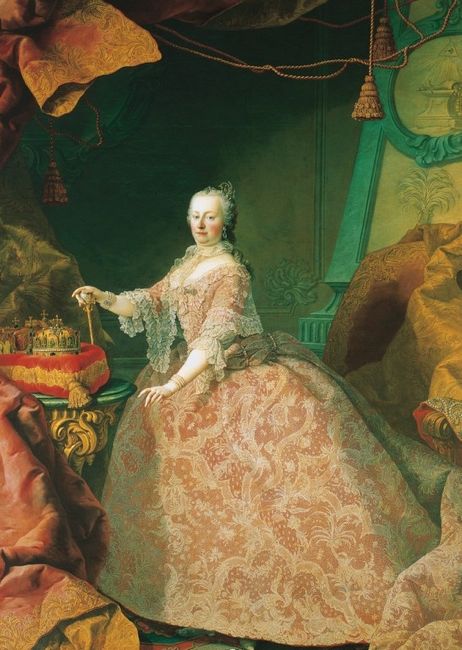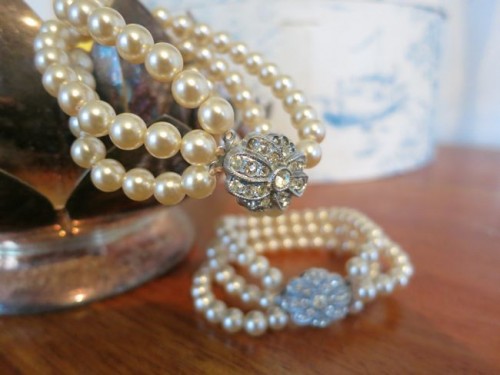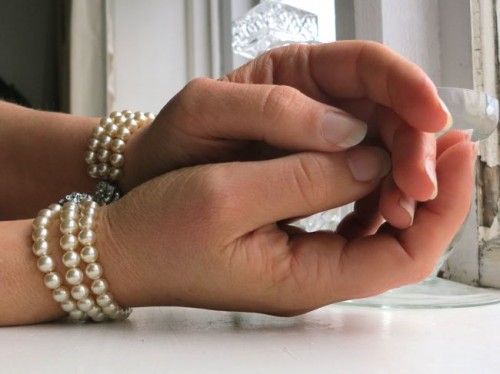I’m not sure if I have mentioned this before, but my name, Leimomi, means (at its most basic, Hawaiian being a language with many layers of meaning to every phrase) a necklace (lei) of pearls. Because of this, I feel a particular affinity for pearls.
I also just plain like their subtle elegance, their luminous sheen, and their purity: a pearl in the fanciest setting looks much like a pearl straight out of an oyster shell. Any other gemstone, on the other hand, must be altered and refined almost beyond recognition before being set.
Pearls were also one of the most popular gemstones historically. Up until the development of cultured pearls in 1916, natural pearls were often worth far more than diamonds. Ironically, only a few decades before cultured pearls became common and the price of pearls plummeted, a wealthy New Yorker traded their Fifth Avenue mansion to the jeweler Cartier for a double strand pearl necklace. At the time the necklace was valued at US$1 million. The mansion is now Cartier’s showroom.
I have a number of pearl necklaces, including cultured pearls, irregular baroque pearls, and vintage synthetic pearls. They have come in very useful with many period frocks.
I did not, however, have any pearl bracelets, and I wanted some. I’ve been studying the pearl bracelets show in 18th century paintings for some time (not portrait bracelets with pearls, though I’ll be writing about them soon). Some of them are clearly just ropes of pearls twisted around the wrist (something that I’ve done in a pinch), but others seem to be purpose-made bracelets, with no overlap.
Madame de Pompadour wears them in a couple of her portraits:

François Boucher (1703—1770), Madame de Pompadour (1721-1764), 1759

François Boucher, Madame de Pompadour, 1756
These may be the same bracelets: the pearls are the same size, and four strands are show in both paintings.
Izabella Pontiatowska, sister to Stanislaw II, King of the Polish-Lithuanian Commonwealth, had a three strand set:

Izabella Poniatowska Branicka by Marcello Bacciarelli, ca. 1757 (Muzeum Narodowe we WrocÅ‚awiu – WrocÅ‚awia Poland)
Marie Antoinette was also a fan. She’s wearing a three strand bracelet (probably a matching pair) in this portrait by Vigee Le-Brun, and possibly the same set in this portrait, and again in Le-Bruns formal version of the portrait with the rose (though the pearls look slightly smaller), and Le Clercq’s sketch with her son. She also had a two-strand set, shown here, and a five strand set shown in Wertmüller’s portrait with her children. It’s possible that they are all the same bracelet, with additional strands added and taken away.

Marie Antoinette & Children, 1783, Vigee Le Brun
Maria Antoinette’s mother Maria Theresa is also shown with pearl bracelets, and her portrait answered my big question about these bracelets: namely, how do you put them on?

Maria Theresia of Austria at the Age of 35 (1752:1753), by Martin van Meytens, Schönbrunn Palace, Vienna
Maria’s bracelet appears to have a clasp on the underside to fasten the four strands. It’s possible that what shows in the portrait is a portrait bracelet, but this seems unlikely, as every other example shows them worn on the outside of the wrist.
So, based on the idea of a 2-5 strand bracelet, fastened with a jewelled clasp, I went looking for suitable materials. I found two matching vintage 1940s diamante clasps with a reasonable 18th century aesthetic, and a three-strand 1940s synthetic pearl necklace with pearls of the right size, colour and lustre that was missing a couple of beads to cannibalise.
A few hours of work and this is what I came up with:



I can’t wait to wear them with my 1760s blue silk taffeta Robe à la Française, which I’ve already dubbed the Frou-Frou Francaise, because it’s so deliciously scroop-y!
The Challenge: Pretty, Pretty Princesses
Fabric: None
Pattern: None
Year: Fashionable throughout the second half of the 18th century
Notions: Linen thread, vintage synthetic pearls, vintage diamante pearl clasp
How historically accurate is it? My part of the work is probably pretty accurate, but obviously synthetic pearls are not. There probably were 18th century clasps that used paste jewels rather than real diamonds.
Hours to complete: 4 + shopping and sourcing materials. I had to re-strand one bracelet as I mis-counted and strung it with one too few pearl on each strand.
First worn: Around the house today, while continually holding my hands in front of myself to admire how pretty they looked.
Total cost: $4 per clasp, + $8 for the necklace, = NZ$16 for the pair.

They’re lovely! Thanks for sharing them with us.
Thank you, and you’re welcome!
So pretty! And I think your “theme song” should be Glenn Miller’s “String of Pearls” 🙂
Well, I do like Glenn Miller, and I can imagine me wearing these and my Sea at Sunset dress and dancing to ‘String of Pearls’, but it doesn’t quite fit with the 18th century dating 😉
Very pretty! I love pearls as well, but there are few things in the world of jewelry that I don’t like! I’m looking forward to seeing them with your new dress!
Thanks Zach! The frock is a couple of months, and a lot of hard work, off, but I’m sure it will be worth it!
What a great idea, the bracelets look great. I love pearls, they are so beautiful.
Thanks Kate!
They’re lovely.
I’ve just finished reading a new novel, The Other Typist, set in 1920’s New York. One of the characters describes her matching diamond bracelets as being like handcuffs. (She also works in a police precinct office). That’s what I thought of when I saw your pearl cuffs!
Are you able to spell out a phonetic pronunciation of your name? I have no idea how it should sound.
Thanks Stephanie!
Hehe. Pearl and diamante handcuffs. I really like matching bracelets – it’s unusual these days. And I have rather pretty hands and wrists, and use them a lot when I lecture, so it works well for me 😉
Leimomi is pronounced Lei (like a flower lei – it’s a bit softer and has more of an uplift on the ‘i’ than ‘lay’, so all those dreadful movies/tv shows that have jokes about getting ‘lei’d/laid’ in Hawaii are both crude and wrong) / mo (as in moment) / mi (and in me/myself) Lei/mo/mi.
How interesting, I never knew how popular pearls were in the past although I knew they were worn! Thanks for sharing this!
You’re welcome!
The popularity of pearls makes sense if you think about it – they are actually rarer than say, diamonds, and arrive pretty much ready-to-go (except for a threading hole), whereas many other gemstones are much harder to cut. Plus, efficient cutting techniques are quite modern, so diamonds, for example, weren’t nearly as brilliant or sparkling in the 18th century (though they were popular).
Beautiful! The clasps you found are just wonderful. Thanks for sharing your research!
Thank you! I was really lucky with the clasps. There is a great little textile and jewellery focused antique store in Wellington that had them.
And you’re welcome – I’ve learned so much from other people who have generously shared their research, so I feel obliged to pass it on.
I have seen early bracelets like this at antique shows. And, they came back in the late 1940’s & 50’s – colored glass as well as faux pearls. In the jewelry my MIL’s left us, there were some examples – all broken, as I recall. She worked in the nursery at her church and I have a feeling babies tend to grab a them.
Oh, how cool! Were the ones you’ve seen 18th century, and did they have clasps?
I knew they came back in the ’40s (and even the ’30s) – that’s why my clasps were so easy to find.
They are pretty! They will look fabulous with the blue taffeta gown.
I had no idea that pearls used to be so expensive. It makes me wonder about those enormous pearl drops that you see in every other portrait of a 17th century girl. How could there possibly be that many?
Thank you!
I think a lot of those enormous pearl drops were false pearls – lustre over glass. And some only existed in the artist’s imagination, as a way to add status to their sitter. Or existed in the artists wardrobe, and went on every sitter.
Lovely! How lucky you were to find two matching vintage clasps.
Thanks Lynne! Yes, I was very excited when I found those clasps!
Brilliant!
Thanks Stella!
Actually, false glass pearls were period accurate. Seems the Elizabethans mined the seas pretty dry, so real pearls were ungodly expensive, and most women, even Antoinette, had more fake than real pearls.